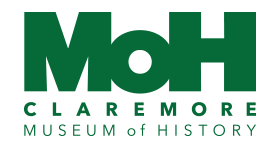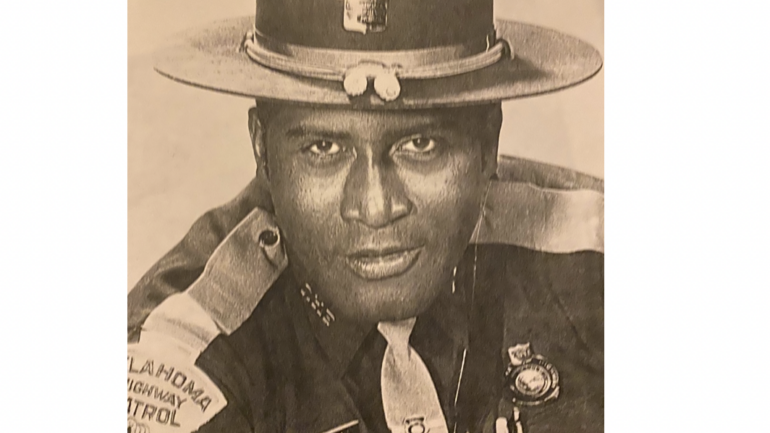Telling the history of Claremore…one story at a time
Published in the March 1947 Ranchman Magazine, by Ferne E. King.
Long before the sun topped the mountains of Eastern Tennessee, on a morning sixty-one years ago, a mule team hitched to a wagon, headed west to begin the long trail to the Indian Territory. In this wagon was the young boy, Joe Hogue, who was to be an Oklahoma cowboy, cattleman and banker. He doesn’t remember just how long afterwards they landed in Maysville, I. T. but “It was just after Dan Tittle was killed, everybody wore 45’s then and mostly attended to their own law business.” He remained in Maysville for a year and then went to Van Buren, Arkansas, but after a year or so came back to the Territory and located in the full-blood country along Little Lees Creek, near Sallisaw. Reminiscing of those days, Mr. Hogue said “Dave Faulkner lived down there too. His father, Dave Sr., was an advisor for all the Indians; his brand was the D2. We used to ride to Ft. Smith, quite often and when night came we could just stay with anybody and were always welcome, the full bloods didn’t farm much and didn’t have much, but you were always welcome to what they had.”
In 1887, deciding he wanted to settle in good cattle country, Hogue came to Rogers county. He says there were several big outfits operating there, the W. E. Halsell, Dannenburg, “Buge” Little and Jim Hall were some of them. Clem Rogers had a big outfit down around Claremore and Tom McSpadden was handling lots of cattle…his brand was the TM. It was a great prairie hay country, Fred L. Kelly was the biggest hay dealer in the state, J. W. Stewart followed him and now his daughter Martha Calkins carries on the business. Chelsea has become one of the largest hay shipping points in the west.
When asked if he ever had any trouble with the outlaws in those early days, Mr. Hogue said “No, not to speak of…I just attended to my own business and let them tend to theirs. Old Man Tom Starr was one of the wilder bunch and a full blood by the name of Naked Head had an itchy trigger finger. Bill Pigeon wasn’t so bad. Oh, he might have killed a man or two. I know he killed someone that was stealing his hogs. “Big Chewy” was another one of them. One of the laws was taking “Big Chevy” to Ft. Smith for trial and when they were making camp along the road, Chewy was driving a tent peg and made a mislick and knocked the law in the head.” “The Daltons lived here too…I didn’t know them very well. They weren’t here very steady, just in and out, you might say. One day they went down to Adair and came back that night and stayed at their mother’s and the next day they went to Coffeyville. They didn’t come back anymore.” “But”, Mr. Hogue said, Jim Kell and I used to ride the whole country buying yearlings, carried our money on us and paid cash…camped wherever night found us and we never had much trouble with any of them.”
Here at Chelsea, Joe Hogue met and married the charming Mary Clarke, whose family had also moved to The Territory from Tennessee. She was an ideal wife for the rising young cattleman, as she was a descendant of the famous Meigg-Walker families and in her veins flowed the blood of those who build empires.
Thinking of her gentle and cultured rearing we asked her if she enjoyed the pioneer living of those days. “Oh, yes,” she said, “We had wonderful times. We ladies had a lovely embroidery club…there was Mrs. McSpadden, Mrs. Strange, Mrs. Dannenburg, Mrs. Scott, Mrs. Lane, Mrs. Kill and myself. We would meet in the afternoons and visit and embroider and have a dinner at night and once a year we entertained our husbands. I remember one year we had a Halloween party…we rented our costumes from Kansas City and it was really quite grand. At round-up time we all cooked for days ahead of time making pies and cakes and baking hams and chickens. Everybody came and just slept anywhere, never thought of going to a hotel…it was really a gala event. Every day we would have match roping and the last day we would always have a match horse race…yes, indeed, we had great times.”
“Yes,” Mrs. Hogue said, “We had a big round-up every spring. Halsell, Hall, Franklin and others would meet at Pryor (it used to be called Coo-Wah-Yah, that was Cherokee for Huckleberry, then Pryor Creek and now just Pryor) and Wagner and at the mouth of Grand River. Nearly always camped at John Hogan’s. We covered the country from Ft. Gibson north to the Kansas line gathering the cattle…they were nearly all Whitefaces. Sometimes the “free pasture” boys and the Cherokees had a little trouble, but not bad, just mostly fights.”
They had lots of roping contests in those days, the forerunners of the colorful rodeo of today. The Clem Van place was one of the favorite locations for the contests. Mr. Hogue recalls that Bill Sharpe, Jim Kell, Jim Hopkins and Leonard Trainor were mighty good rodeo hands and added modestly, “I always rode good horses and used a good saddle, they are pretty important in the rodeo game.”
In 1903 Hogue went to the St. Louis World’s Fair with the Mulhall’s Wild West Show. He said there was a trainload went from around there but with the exception of Bill Sharpe and Jim Kell, he couldn’t remember who went. They camped in a park there near the Fairgrounds and he didn’t know which attracted the most attention…the Indians or the cowboys.
Hogue said he remembered the first time he ever saw Will Rogers…”It was over at the Hall ranch…he was a boy of about fourteen and was fooling around with his rope. Will was a leader among the boys…always had the gift of gab and was good humored and jolly. I can just see him yet…playing with his rope and chewing his gum.” There was a package of gum in the coat which he wore on that last tragic journey.
As it happened, Hogue went with Will to his first roping. Hogue was shipping cattle to St. Louis and Will shipped his little horse, Comanche and went with him. That was the first bull dogging that Mr. Hogue ever saw. Bill Pickett put on the exhibition. Lucile Mulhall was there also and “She was a mighty good hand…for a girl.”
As the years passed Joe Hogue continued to buy cattle and land and when the bank was opened at Chelsea, he was one of the directors, and later was made president which position he still holds, although he is now the only one living of the original directors.
The Hogues have three living children, Clarke, one of the best steer ropers of former years who now owns and operates the Oklahoma Com. Co. at Tulsa Stock Yards; Lee, who is with the Drake Contracting Co.; and Irskine, who teaches in the Ponca City schools.
Many years have passed since little Joe Hogue left the mountains of Tennessee to grow up in the new state. Boy and man, he has seen many changes since he first reached the Indian Country. He has seen the grass of prairies torn by the plows of the nesters, seen the free range barred by fences, seen the black gold gush from the Oklahoma oil wells, the first in the state drilled near his own home town of Chelsea, seen a raw territory develop into a powerful state. He has lived a long and useful life, he is the head of a fine family and a prominent citizen, and he still holds his faith in GRASS, WATER, AND CATTLE.



